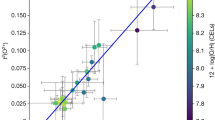Abstract
Of the light elements, the primordial abundance of deuterium relative to hydrogen, (D/H)p, provides the most sensitive diagnostic1 for the cosmological mass density parameter, ΩB. Recent high-redshift D/H measurements are highly discrepant2,3,4,5,6, although this may reflect observational uncertainties7,8. The larger primordial D/H values imply a low ΩB (requiring the Universe to be dominated by non-baryonic matter), and cause problems for galactic chemical evolution models, which have difficulty in reproducing the steep decline in D/H to the present-day values. Conversely, the lower D/H values measured athigh redshift imply an ΩB greater than that derived from 7 Li and 4 He abundance measurements, and may require a deuterium-abundance evolution that is too low to easily explain. Here wereport the first measurement of D/H at intermediate redshift(z = 0.7010), in a gas cloud selected to minimize observational uncertainties. Our analysis yields a value of D/H ((2.0 ± 0.5) × 10−4) which is at the upper end of the range of values measured at high redshifts. This finding, together with other independent observations, suggests that there may be inhomogeneity in (D/H)p of at least a factor of ten.
This is a preview of subscription content, access via your institution
Access options
Subscribe to this journal
Receive 51 print issues and online access
$199.00 per year
only $3.90 per issue
Buy this article
- Purchase on Springer Link
- Instant access to full article PDF
Prices may be subject to local taxes which are calculated during checkout

Similar content being viewed by others
References
Epstein, R. I., Lattimer, J. M. & Schramm, D. N. The origin of deuterium. Nature 263, 198–202 (1976).
Tytler, D., Fan, X.-M. & Burles, S. Cosmological baryon density derived from the deuterium abundance at redshift z = 3.57. Nature 381, 207–209 (1996).
Burles, S. & Tytler, D. Cosmological deuterium abundance and the baryon density of the universe. Science (submitted).
Rugers, M. & Hogan, C. J. Confirmation of high deuterium abundance in quasar absorbers. Astrophys. J. 469, L1–L4 (1996).
Carswell, R. F., Rauch, M., Weymann, R. J., Cooke, A. J. & Webb, J. K. Is there deuterium in the z=3.32 complex in the spectrum of 0014 + 813? Mon. Not. R. Astron. Soc. 268, L1–L4 (1994).
Rugers, M. & Hogan, C. J. High deuterium abundance in a new quasar absorber. Astron. J. 111, 2135–2140 (1996).
Tytler, D., Burles, S. & Kirkman, D. New Keck spectra of Q0014 + 813: annulling the case for high deuterium abundances. Preprint astro-ph/9612121.
Songaila, A., Wambler, E. J. & Cowie, L. L. Ahigh deuterium abundance in the early Universe. Nature 385, 137–139 (1997).
Webb, J. K., Carswell, R. F., Irwin, M. J. & Penston, M. V. On measuring the deuterium abundance in QSO absorption systems. Mon. Not. R. Astron. Soc. 250, 657–665 (1991).
Wampler, E. J. Alternative hydrogen cloud models. Nature 383, 308 (1996).
Lanzetta, K. M., Turnshek, D. & Sandoval, J. Ultraviolet spectra of QSOs, BL Lacertae objects, and Seyfert galaxies. Astrophys. J. Suppl. Ser. 84, 109–184 (1993).
Webb, J. K. QSO absorption lines.Thesis, Cambridge Univ.((1987)).
Vidal-Madjar, A., Ferlet, R. & Lemoine, M. Deuterium abundance and cosmology. Preprint astro-ph/9612020.
Pagel, B. E. J. Nucleosynthesis and Chemical Evolution of Galaxies (Cambridge Univ. Press, (1997)).
Schramm, D. S. & Turner, M. S. Deuteronomy and numbers. Nature 381s, 193–194 (1996).
Hata, N., Steigman, G., Bludman, S. & Langacker, P. Cosmological implications of two conflicting deuterium abundances. Phys. Rev. D 55s, 540–547 (1997).
Vangioni-Flam, E. & Cassé, M. Cosmological and astrophysical consequences of a high primordial deuterium abundance. Astrophys. J. 441, 471–476 (1995).
Hogan, C. J. Big bang nucleosynthesis and the observed abundances of light elements. Preprint astro-ph/9609138.
Copi, C. J., Olive, K. A. & Schramm, D. N. Implications of a primordial origin for the dispersion in D/H in quasar absorption systems.Preprint astro-ph/9606156.
Copi, C. J., Schramm, D. N. & Turner, M. S. Big-bang nucleosynthesis and the baryon density of the universe. Science 267, 192–199 (1995).
Jedamzik, K. & Fuller, G. M. Nucleosynthesis in the presence of primordial isocurvature baryon fluctuations. Astrophys. J. 452, 33–61 (1995).
Jedamzik, K. & Fuller, G. M. Is the deuterium in high redshift Lyman limit systems primordial? Preprint astro-ph/9609103.
White, M., Viana, P. T. P., Liddle, A. R. & Scott, D. Cold dark matter models with high baryon content. Mon. Not. R. Astron. Soc. 283, 107–118 (1996).
White, S. D. M., Navaro, J. F., Evrard, A. E. & Frenk, C. S. The baryon content of galaxy clusters: a challenge to cosmological orthodoxy. Nature 366, 429–433 (1993).
Acknowledgements
This work is based on observations with the NASA/ESA Hubble Space Telescope, obtained at the Space Telescope Science Institute, which is operated by the Association of Universities for Research in Astronomy, Inc., under NASA contract. K.M.L. was supported by NASA, STScI and NSF; M.L. was supported by NASA, DoE and NSF at the University of Chicago; J.K.W. thanks M. Ashley, J. Barrow, A.Little and R. J. Tayler for discussions, and SUN Microsystems Australia Pty Ltd for providing computing facilities for this work.
Author information
Authors and Affiliations
Rights and permissions
About this article
Cite this article
Webb, J., Carswell, R., Lanzetta, K. et al. A high deuterium abundance at redshift z = 0.7. Nature 388, 250–252 (1997). https://doi.org/10.1038/40814
Received:
Accepted:
Issue Date:
DOI: https://doi.org/10.1038/40814
This article is cited by
-
The cosmic origin of deuterium
Nature (2000)
Comments
By submitting a comment you agree to abide by our Terms and Community Guidelines. If you find something abusive or that does not comply with our terms or guidelines please flag it as inappropriate.



